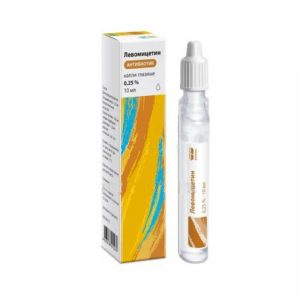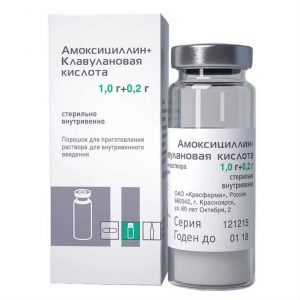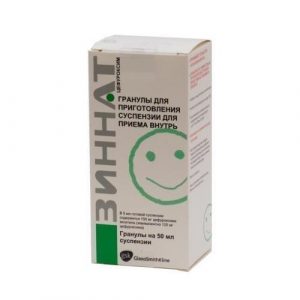Description
Release form
Film-coated tablets
Indications
Treatment of bacterial infections caused by microorganism strains sensitive to the combination of amoxicillin / clavulanic acid:
upper respiratory tract infections (including ENT infections), including recurrent tonsillitis, sinusitis, otitis media (lower respiratory tract infections) bronchitis, pneumonia)
infections of the urinary system (cystitis, urethritis, pyelonephritis)
infections of the female genital organs (septic abortion, postpartum sepsis, pelvic organ sepsis)
abdominal infections and postoperative intraabdominal complications, including intraabdominal sepsis
biliary tract infections (cholecystitis, cholangitis)
skin and soft tissue infections (burns, abscesses, subcutaneous tissue inflammation) infections, including dentoalveolar abscesses
infections of bones, joints and connective tissue (including osteomyelitis)
prevention of infectious complications after surgery on the organ digestive tract, pelvic, head and neck, heart, kidneys, amputation of limbs, joint replacement.
Amoxiclav is used to treat mixed infections caused by both microorganisms sensitive to amoxicillin and microorganisms producing β-lactamases.
Contraindications
hypersensitivity to amoxicillin and other penicillin antibiotics, clavulanic acid and other components of the drug cholestatic jaundice or hepatitis caused by a history of penicillin antibiotics.
Special instructions
Before starting amoxicillin / clavulanic acid therapy, it is necessary to carefully examine the patient’s presence of hypersensitivity reactions to penicillins, cephalosporins or other beta-lactam substances.
Serious and sometimes fatal (anaphylactic) hypersensitivity reactions have been reported in patients treated with penicillin. These reactions are more common in people with a history of hypersensitivity to penicillin and a history of atopy. With the development of an allergic reaction to amoxicillin / clavulanic acid, discontinue therapy with this drug and switch to another alternative treatment.
If the infection is resistant to amoxicillin, consider using amoxicillin / clavulanic acid instead of amoxicillin.
At high risk of pathogen resistance to beta-lactam antibiotics, Amoxiclav 2X should not be used. It is not recommended to use the drug for the treatment of penicillin-resistant S. pneumoniae.
Seizures may develop in patients with impaired renal function and those taking a high dose of the drug.
Amoxicillin / clavulanic acid should not be prescribed for infectious mononucleosis, since a measles-like rash (on amoxicillin) may occur.
The simultaneous use of allopurinol during treatment with amoxicillin may increase the likelihood of developing skin allergic reactions. Data on the simultaneous use of allopurinol and the drug Amoxiclav 2X are currently not available.
Prolonged use of the drug may cause excessive growth of insensitive microorganisms.
The appearance at the beginning of treatment of generalized erythema with pustular rashes and fever may be a symptom of the development of acute generalized exanthematous pustulosis. With the development of this reaction, it is required to stop the use of the drug Amoxiclav 2X and no longer use amoxicillin in the future.
The drug should be used with caution in patients with hepatic impairment.
Cases of impaired liver function have been reported mainly in men and elderly patients, are quite rare in children who took the drug for a long period of time. Signs and symptoms usually develop during or immediately after the start of treatment, but in some cases can occur only a few weeks after stopping therapy. These symptoms are usually reversible. Complications from the liver can be severe and can be fatal in extremely rare cases. They almost always develop in patients with serious concomitant diseases or in patients taking other drugs that affect the liver.
The development of antibiotic-associated colitis is characteristic of any antibacterial drugs, including amoxicillin, and can vary in severity from moderate to life-threatening. Therefore, it is important to consider this diagnosis when prescribing the drug to patients suffering from diarrhea during or after the use of any antibiotics. If antibiotic-associated colitis occurs, immediately stop using Amoxiclav 2X. After consulting a doctor, appropriate therapy should be prescribed. Drugs that reduce peristalsis are contraindicated in this situation.
With prolonged therapy, it is recommended to regularly evaluate the function of organ systems, including kidney, liver, and hematopoietic function.
A dose adjustment of oral anticoagulants is necessary to maintain the desired level of blood coagulation.
In patients with impaired renal function, a dose adjustment is required depending on the severity of the impairment.
In patients with reduced diuresis, crystalluria was very rarely observed, mainly during parenteral therapy. During treatment, the patient is recommended to drink plenty of water in order to avoid the possible development of crystalluria. According to the data obtained, amoxicillin settles in the catheters of the bladder (mainly with intravenous administration of large doses), in this case, it is necessary to regularly monitor the patency of the catheter.
During treatment with amoxicillin, enzymatic glucose oxidase methods should be used when testing for the presence of glucose in the urine, since false positive results are possible with non-enzymatic methods.
The presence of clavulanic acid in Amoxiclav 2X may lead to nonspecific binding of immunoglobulin G and albumin to red blood cell membranes and false positive Coombs results.
Bio-Rad Laboratories Platelia Aspergillus EIA positive results were obtained in patients taking amoxicillin / clavulanic acid who were subsequently not infected with Aspergillus infection, but there is no evidence of cross-reactions using non-Aspergillus polysaccharides and polyfuranoses. Thus, the positive results of analyzes of patients taking amoxicillin / clavulanic acid should be interpreted with caution and confirmed by other diagnostic methods.
Pregnancy
Animal studies do not indicate a direct or indirect harmful effect in relation to pregnancy, fetal / fetal development, childbirth or postnatal development.
Currently, there is a limited amount of data on the use of Amoxiclav 2X during pregnancy in humans, which did not reveal an increased risk of congenital malformations. In a clinical study in women with premature rupture of the membranes, a causal relationship was found between prophylactic treatment with amoxicillin / clavulanic acid and an increased risk of necrotic enterocolitis in the newborn. It is not recommended to use the drug Amoxiclav 2X during pregnancy, use is possible only if absolutely necessary as directed by a doctor.
Lactation
Both active substances are excreted in breast milk (there is no evidence of the effect of clavulanic acid on breastfeeding). Therefore, with breastfeeding, symptoms such as diarrhea and fungal infections of the mucous membranes may occur, in these cases, breastfeeding should be discontinued. Amoxiclav 2X may be used during breastfeeding only after assessing the benefit / risk by the attending physician.
Peculiarities of the effect of the drug on the ability to drive a vehicle or potentially dangerous mechanisms
No studies have been conducted to identify effects affecting the ability to drive a vehicle and equipment. However, Amoxiclav 2X may cause side effects such as allergic reactions, cramps, which can affect the ability to drive a car and moving machinery.
Composition
1 tab.
active substances (core):
amoxicillin (in the form of trihydrate) 500 mg
clavulanic acid (in the form of potassium salt) 125 mg
excipients: silicon dioxide colloid – 9 mg, crospovidone – 45 mg, croscarmellose sodium – 35 mg, magnesium stearate – 20 mg, MCC – up to 1060 mg
film coat: hypromellose – 17.696 mg, ethyl cellulose – 0.864 mg, polysorbate 80 – 0.96 mg, triethyl citrate – 0.976 mg, titanium dioxide – 9.36 mg, talc – 2.144 mg
Side effects of
are usually mild and fast-passing.
From the gastrointestinal tract: diarrhea (4.1%), nausea (3%), vomiting (1.8%) and dyspepsia (1.6%) rarely – anorexia, flatulence, gastritis, stomatitis, glossitis or discoloration of the tongue, enterocolitis. Pseudomembranous colitis caused by the toxin produced by Clostridium difficile may develop during or after drug discontinuation.
From the blood system: anemia (including hemolytic anemia), thrombocytopenia, eosinophilia, leukopenia, agranulocytosis.
From the nervous system: rarely – headache, dizziness, insomnia, agitation, anxiety, inappropriate behavior, confusion, convulsions, hyperactivity.
Hepatobiliary disorders: possibly an increase in liver function tests, including an asymptomatic increase in the activity of AcAT and / or AlAT, alkaline phosphatase and serum bilirubin levels. Impaired liver function most often occurs in elderly patients or in patients receiving prolonged treatment. Hepatitis and cholestatic jaundice are rare. Signs and symptoms usually occur during or immediately after treatment, but in some cases may not appear for several weeks after the end of treatment.
From the skin: rash, urticaria, angioedema, rarely erythema multiforme, Stevens-Johnson syndrome, exfoliative dermatitis, toxic epidermal necrolysis.
From the urinary system: rarely – interstitial nephritis and hematuria.
Other: candidal vaginitis (1%), fever prolonged use of the drug may cause oral candidiasis.
Drug Interactions
Oral Anticoagulants
Oral anticoagulants and antibiotics of the penicillin group are widely used in practice without reports of interaction. However, in literature there was an increase in the international normalized ratio in patients taking acenocumarol or warfarin together with amoxicillin. If the simultaneous use of drugs is necessary, prothrombin time or the international normalized ratio should be carefully monitored when prescribing and canceling amoxicillin. Moreover, a change in the dosage of oral anticoagulants may be required.
Methotrexate
Penicillin group drugs can reduce methotrexate excretion, which causes a potential increase in toxicity.
Probenecid
Concomitant use of probenecide is not recommended. Probenecid reduces renal tubular secretion of amoxicillin. Joint use with Amoxiclav 2X may increase blood levels of amoxicillin, but not clavulanic acid.
The simultaneous use of allopurinol and Amoxiclav 2X may increase the risk of allergic reactions. Data on the simultaneous use of allopurinol and the drug Amoxiclav 2X are currently not available.
In patients taking mycophenolate mofetil, when combined with the drug Amoxiclav 2X, the concentration of the active metabolite of mycophenolic acid when prescribing the initial dose is reduced by approximately 50%. A change in the concentration level of the initial dose may not correspond to a change in the total concentration of mycophenolic acid.
An overdose of
is unlikely. Taking the drug in a high dose can cause overdose symptoms: agitation, insomnia, dizziness, and sometimes convulsions. The treatment is symptomatic. Amoxiclav can be removed from the body by hemodialysis.
Storage conditions
Store in a dry place at a temperature not exceeding 25 ° C.
Keep out of the reach of children!
Expiration
2 years
Do not use after the expiry date stated on the packaging.
Deystvuyuschee substances
Amoxicillin, clavulanic acid
pharmacy terms for prescription
Form of Treatment
tablets
Appointment
Pregnant at the doctor’s appointment, Children over 12 years old, Prescribing Children, Nursing Moms Prescribing, Adult Prescription
Possible product names
Amoxiclav 2x tablets coated film 500 mg + 125 mg 15 pcs.




